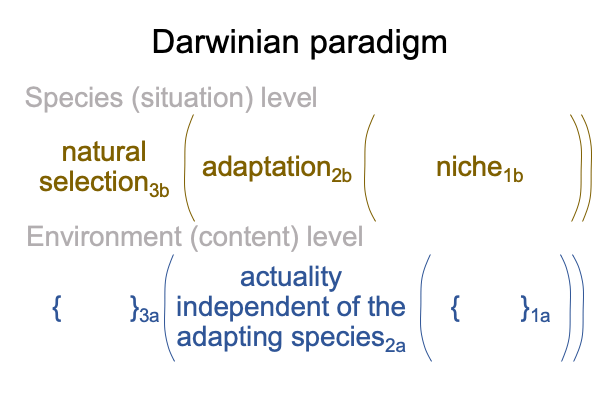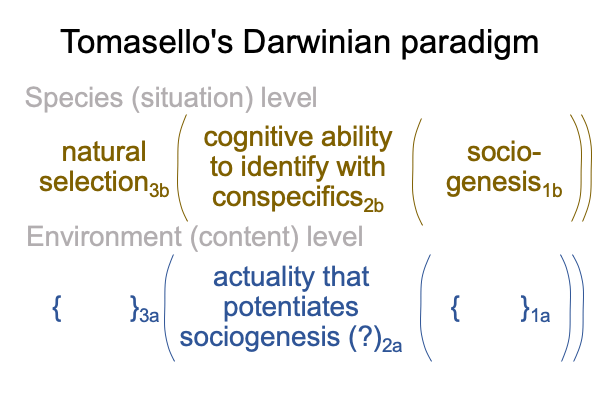0010 What is an adaptation? What is a phenotype?
What is an adaptation? What is a niche?
Whenever there are two actualities, their corresponding nested forms may sensibly relate to one another in a two-level interscope or they may intersect.
The adaptation and the phenotype form an intersection. The structure is developed in Comments on Dennis Venema and Scot McKnight’s Book (2017) Adam and the Genome (available at smashwords and other e-book venues).
The adaptation and the niche belong to the situation level of a two-level interscope. This interscope is developed in the e-work mentioned above.
0011 The two-level interscope for natural history looks like this.

On the situation level, the normal context of natural selection3b brings the actuality of an adaptation2b into relation with a niche1b. “Niche1b” is a label for “the potential1b of an actuality independent of the adapting species2a“.
An inquirer does not need to know the normal context3a or the foundational potential1a of the actuality independent of the adapting species2a. One need only posit its2a presence.
0012 Of course, Tomasello does not know this picture of natural history. He also does not know that genetics expresses the same relational structure. A phenotype2b emerges from (and situates) its genotype1b in the normal context of body development3b (ontogenetics3b). The genotype1b expresses the potential1b of DNA2a.
Then what happens?
The adaptation2b and the phenotype2b intersect and constitute a single, contradiction-filled actuality called “an individual”, “a species” or “a genus”.
0013 What does this have to do with Tomasello’s proposal that one adaptation potentiates subsequent adaptations?
Well, since adaptation and phenotype intersect, and since Tomasello cannot disentangle the two, his argument sort of confounds phylogeny (changes in adaptations in a lineage over evolutionary time) and ontogeny (the phenotypic expressions of those adaptations).
Such is the nature of the disciplines of natural history and genetics. They appear to be separate. But they study the same thing.
0014 So, what is Tomasello’s hypothesis?
In terms of phylogenetics (natural history and adaptations), hominins evolve the ability to “identify” with conspecifics, allowing collaborative activities, as well as a theory of mind.
In terms of ontogenetics (genetics and phenotypes), children innately anticipate that they will grow up amidst individuals who are habituated in “identifying” with conspecifics. “Culture” is another word for that habituation.
0015 Tomasello uses the label, “sociogenesis”, to capture the essence of the business of identifying with conspecifics.
In terms of natural history, sociogenesis1b is the human niche1b.
In terms of genetics, sociogenesis is what the phenotype2b anticipates when it2b engages the world.
Humans are sociogenetic animals.
0016 So, how does this fit into the two-level Darwinian paradigm?
Here is my guess.

